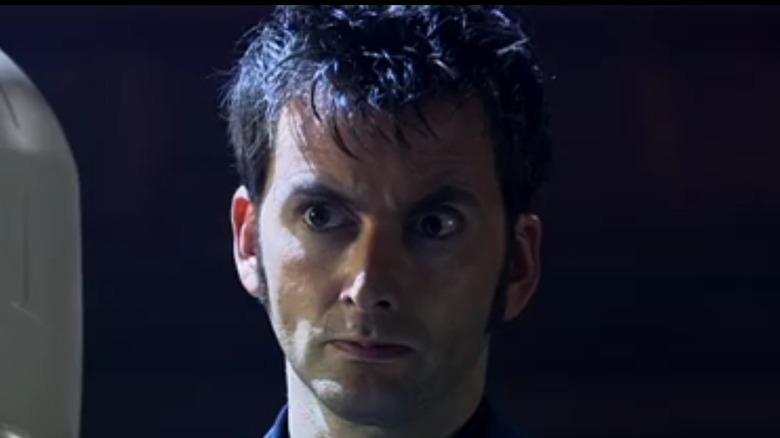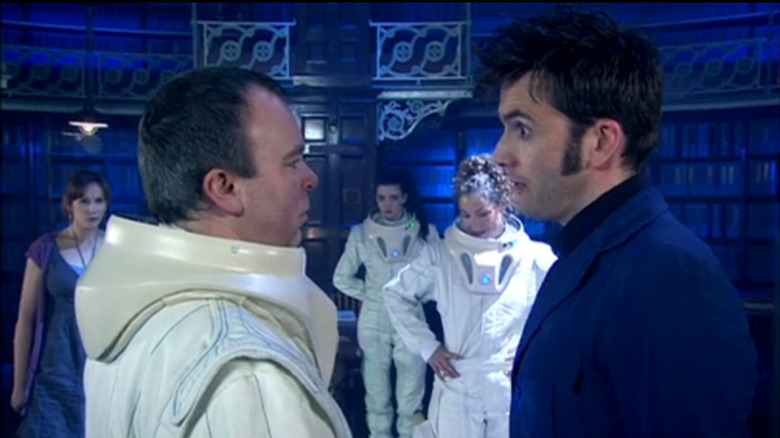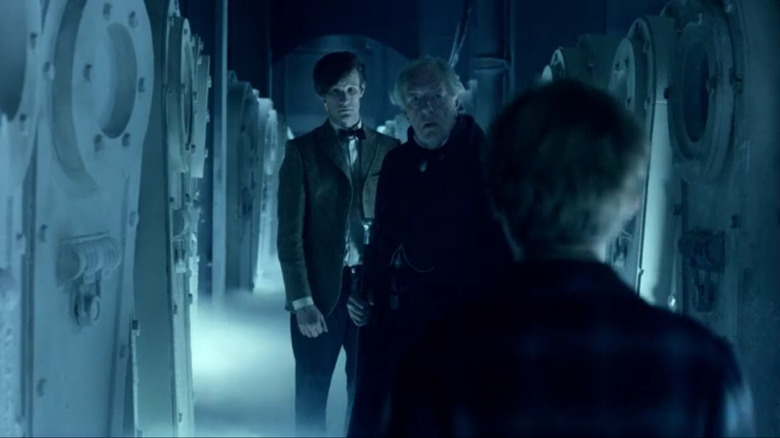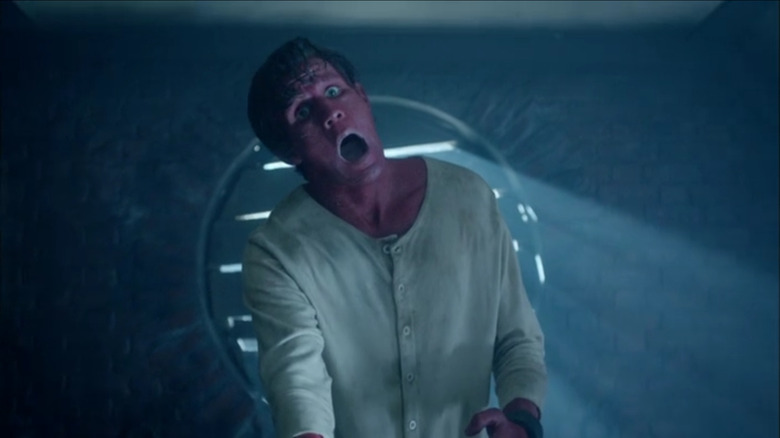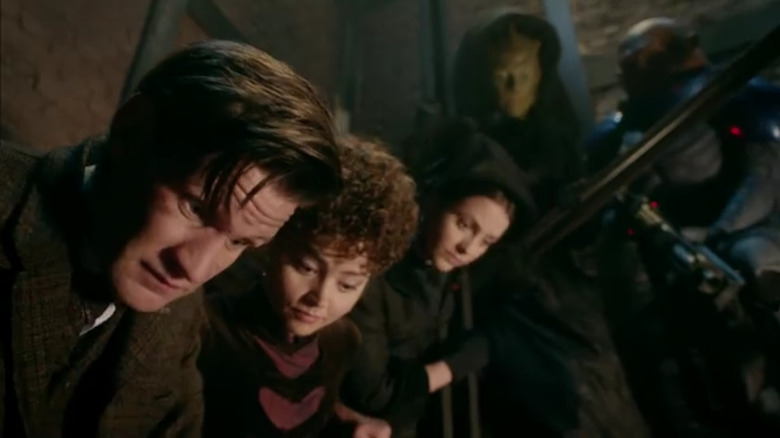The Villain Theory That Would Change Everything On Doctor Who
"Doctor Who" has been a staple of British TV since its inception in 1963, and with the "New Who" revival in 2005, the adventures of the roguish Gallifreyan across all of time and space became a global phenomenon. With 13 versions of the titular character, 40 seasons, and more than 850 episodes, the show has built up a formidable mythos that has spawned innumerable callbacks, references, in-jokes, crossovers, recurring characters, and retcons.
Lore of such abundance combined with an imaginative, loyal, and enthusiastic fanbase has naturally produced a prodigious spring of fan speculation. The New Who era in particular has encouraged viewers to join the dots and look for narrative connections, with season-long setups and payoffs such as the Ninth Doctor's (Chris Eccleston) Bad Wolf, the Tenth Doctor's (David Tennant) Torchwood, and the Eleventh Doctor's (Matt Smith) The Silence. So it's no surprise that Whovians look for connections and apparent coincidences and try to discern a deeper pattern beneath the surface.
One such fan theory posits a cross-series pattern of corporations that appear in four episodes of New Who, each with apparently similar goals and modus operandi. Amino user The_Gallifreyan_Whovian asked whether the Lux Corporation from "Silence in the Library" and "Forest of the Dead," Sardicktown from "A Christmas Carol," and Sweetwater from "The Crimson Horror" might be connected, suggesting some kind of nefarious pan-galactic conspiracy. Their reasoning is that in all three stories, a mysterious organization preserves people in some kind of stasis and has the power to control the atmosphere, and in all three cases, a character named "Abigail" appears.
Does this fan theory have merit? As The_Gallifreyan_Whovian points out, Steven Moffat is involved in all three stories either as writer or showrunner, and Moffat has never been shy of laying early foundations for long-range narrative masterplans.
The Lux Corporation gathered every book ever written
In the Season 4 two-parter "Silence in the Library" and "Forest of the Dead," the Tenth Doctor (David Tennant) takes companion Donna Noble (Catherine Tate) to a planet-sized library that houses every book ever written. Both episodes were written by future showrunner Steven Moffat during then-showrunner Russell T. Davies' tenure. Upon arrival, The Doctor and Donna find the library deserted and apparently devoid of life.
The two episodes are notable for being two of the highest-rated in the New Who era, and also for introducing River Song (Alex Kingston), the archaeologist-criminal who would go on to enjoy a long-running relationship with The Doctor across multiple seasons and regenerations (not to mention becoming his wife). Song is leading an archeological expedition to investigate what happened in the library. The expedition is funded by Strackman Lux (Steve Pemberton) of the Lux dynasty — the family that built the library along with its super-computer CAL. The team soon finds themselves hunted by the Vashta Nerada, a carnivorous species that occupy the library's shadows.
The Doctor ultimately learns that "CAL" stands for Charlotte Abigail Lux (Eve Newton), granddaughter of the library's founder Felman Lux. When Charlotte was diagnosed with a terminal illness, Lux had her consciousness preserved on a hard drive and created the library for her enjoyment. When CAL detected the arrival of the Vashta Nerada, she uploaded all of the library's inhabitants to her hard drive for protection and preserved them in a virtual world. This is also ultimately the fate of River Song, marking the end of her "Doctor Who" tenure from her perspective, and the beginning of it from the Doctor's (it's a timey-wimey thing).
Sardick the loan shark freezes family members as collateral
Written by showrunner Steven Moffat, "A Christmas Carol" finds Amy Pond (Karen Gillan) and Rory Williams (Arthur Darvill) sending out a distress call to The Doctor (Matt Smith) when the starship on which they are honeymooning malfunctions and plunges on a collision course with the planet Ember. The Doctor heads to the planet to find that Kazran Sardick (Michael Gambon), a powerful business magnate and big boss of Sardicktown, is refusing to allow the crippled ship to land, apparently out of mean-spiritedness. The Doctor sets himself the task of reforming Sardick's character using the titular Charles Dickens novel as inspiration.
The cruel and ruthless Kazran Sardick takes after his now-deceased abusive father Elliot (also played by Michael Gambon). Kazran inherited the family loan-sharking business and continues his father's tradition of cryogenically freezing the beloved family members of his clients as collateral against their loans. The Doctor's strategy to reform Kazran Sardick's character is to use the TARDIS to interfere with his timeline and befriend young Kazran (Laurence Belcher), who is suffering under his father's tyrannical rule. Each Christmas, The Doctor and young Kazran un-freeze the beautiful, but terminally ill Abigail Pettigrew (Katherine Jenkins), who has been frozen by Elliot Sardick as security against a loan, and with whom young Sardick begins to fall in love.
The Doctor prevails when, with a clever twist on the "ghost of Christmas future" concept, he introduces Kazran to his younger self, who looks at his future incarnation with the hope that he can break free from his father's evil influence. Kazran relents and allows the distressed starship to safely land.
In Sweetville, 'perfect' people are preserved like dolls
Set in Victorian Yorkshire, "The Crimson Horror" was the 100th episode of the "new Who" revival, starring Matt Smith in his third and final season as the Eleventh Doctor, and written by Mark Gatiss. In a classic detective mystery, the Paternoster Gang — Madame Vastra (Neve McIntosh), Jenny Flint (Catrin Stewart), and Strax (Dan Starkey) — search for The Doctor after he goes missing investigating a spate of bright red corpses washing up in Yorkshire canals. The trail leads the gang to Sweetville, a model village run by moral crusader Mrs. Winifred Gillyflower (Diana Rigg), who is recruiting "perfect" people to join her community. Unbeknownst to the investigators, Gillyflower is preserving her perfect human specimens in a doll-like stasis.
While posing as a Sweetwater applicant, Jenny enlists the help of fellow hopeful Abigail (Michelle Tate) to fake a fainting fit so Jenny can sneak off on an infiltration mission. After Jenny and the gang free The Doctor and Clara (Jenna Coleman) from the clutches of Mrs. Gillyflower, they discover that Sweetwater is a front for a sinister ethnic cleansing plot. Mrs. Gillyflower and her hidden partner Mr. Sweet plan to use a rocket loaded with red venom to seed the planet's atmosphere, wipe out the human population, and repopulate it with their perfectly preserved Sweetwater specimens.
Thanks to the Paternoster Gang removing the rocket's crimson payload, The Doctor foils Gillyflower's plot. In the case of "The Crimson Horror," all three elements of The_Gallifreyan_Whovian's theory are present; an organization with the ability to control the atmosphere, the preservation of humans, and a character called Abigail. But is there enough evidence to link Sweetwater with the Lux Corporation and Sardicktown to reveal an intergalactic plot?
It's more likely that the similarities are coincidental
So is there really a link between the three organizations depicted in "Silence in the Library," "A Christmas Carol," and "The Crimson Horror"? The three stories take place in vastly different places and times: the Lux Foundation Library is located on an unknown planet in the 51st century, Sardicktown exists on the planet Ember in the 44th century, and Sweetville is a community in 19th century Yorkshire, planet Earth. But in the universe of "Doctor Who" where time travel technology and intergalactic conspiracies are a given, this disparity in spatial and temporal locations doesn't negate the theory at all.
Certainly, all three stories involve an organization preserving people. The Lux Foundation's library was founded on the preserved consciousness of Charlotte Abigail Lux, and she subsequently saves thousands of lives by storing their "imprints" on her hard drive. The Sardicks freeze people in cryogenic pods as collateral against their loans. And Mrs. Gillyflower's Sweetville project stores the "perfect" human specimens as living mannequins to repopulate the earth. But there isn't much commonality between their motivations. Felman Lux preserved his Granddaughter's consciousness because she had very little time left to live, and CAL saves the occupants of the library from the vicious Vashta Nerada. Both Sardick and Mrs. Gillyflower have far more nefarious motives. And, while "Silence in the Library/Forest of the Dead" and "A Christmas Carol" both feature a character named Abigail who is (or was) terminally ill and is central to their respective plots, the Abigail in "The Crimson Horror" is a minor character whose only role is to fake a fainting fit to distract the Sweetville staff while Jenny sneaks away.
Of course, we can't be certain, but it seems the similarities found in these three stories are far more likely to be coincidences rather than a deliberate plot device.
